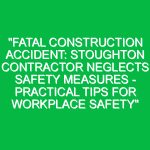US Labor Department investigation finds Ohio food warehouse exposed workers to ergonomic hazards
A recent investigation by the US Department of Labor has revealed that workers at a food warehouse in Fairfield, Ohio were exposed to ergonomic hazards, resulting in severe injuries. The warehouse, operated by Martin-Brower LLC, supplies materials to fast food franchises in several states.
Increased Risk of Musculoskeletal Disorders
The investigation found that workers at the Martin-Brower warehouse were frequently engaged in manual material handling tasks that involved repetitive forceful exertions and awkward postures. These activities put them at a high risk of developing musculoskeletal disorders, particularly in the lower back. Musculoskeletal disorders are a common cause of lost work time.
Inspectors also discovered that the workers were required to work long hours and handle heavy materials, further increasing the risk of injuries. The combination of these factors significantly contributed to the high rate of severe ergonomic injuries at the facility.
Recordable Injury Rates
The total recordable injury rate at the Fairfield facility was almost four times higher than the industry average for grocery and related wholesale product companies between 2020 and 2023. Additionally, the facility’s recordable injury rate for cases involving days away, work restrictions, or employee transfers was four times higher than the industry average during the same period.
These alarming statistics highlight the urgent need for implementing proper safety measures to protect workers from ergonomic hazards and reduce the risk of injuries.
OSHA Citations and Penalties
The Occupational Safety and Health Administration (OSHA) cited the Fairfield warehouse for three serious violations and proposed $41,483 in penalties. The violations were related to the company’s failure to provide a workplace free from known ergonomic hazards and for exposing workers to fire and struck by hazards. OSHA also issued four hazard alert letters to address specific safety concerns.
Martin-Brower LLC has 15 business days to comply with the citations and penalties, request an informal conference with OSHA, or contest the findings before the independent Occupational Safety and Health Review Commission.
Preventing Ergonomic Hazards
Employers in the food services industry, as well as other industries that involve manual material handling, should prioritize the following measures to prevent ergonomic hazards and protect their workers:
1. Training and Education:
Provide comprehensive training to workers on proper lifting techniques, posture, and ergonomics. This will help them understand the risks associated with their tasks and enable them to adopt safe work practices.
2. Engineering Controls:
Implement engineering controls such as adjustable workstations, lifting aids, and ergonomic tools to minimize the physical strain on workers’ bodies.
3. Workstation Design:
Ensure workstations are ergonomically designed to promote proper posture and minimize awkward movements. This includes providing adjustable chairs, footrests, and work surfaces.
4. Regular Breaks:
Encourage workers to take regular breaks to rest and stretch their muscles. This can help reduce fatigue and prevent overexertion injuries.
5. Employee Involvement:
Involve workers in the development and implementation of safety policies and procedures. Their input can provide valuable insights into potential hazards and help create a safer work environment.
By following these practical tips and investing in ergonomic safety measures, employers can significantly reduce the risk of musculoskeletal disorders and create a healthier and safer workplace for their employees.
For more information on preventing musculoskeletal disorders and injuries, visit the official website of OSHA.
Reference: US Labor Department investigation finds Ohio food warehouse exposed workers to ergonomic hazards


